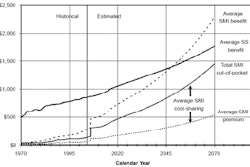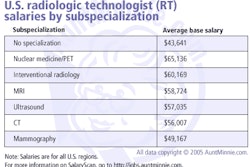Although turf wars over medical imaging have become commonplace between radiologists and other clinical specialties in the U.S., some cardiology and radiology groups have abandoned the battle in order to form mutually beneficial joint venture cardiac imaging centers.
"As technological advances in noninvasive cardiac imaging begin to closely approach the efficacy and sophistication of traditional cardiac diagnostic procedures such as the angiogram, business practices among cardiologists, radiologists, and hospitals will also need to evolve," said healthcare attorney Ken Davis.
Davis, a partner in the law firm Katten Muchin Rosenman in Chicago, offered his thoughts on the opportunities, challenges, and structure of joint venture imaging with cardiologists and radiologists at the Radiology Business Management Association (RBMA) radiology summit in Las Vegas in June.
According to the Blue Cross Blue Shield Association, diagnostic imaging is fast approaching a $100 billion annual business in the U.S., and usage is up nearly 40% over the past five years. In great part, this upsurge in imaging utilization is a reaction of healthcare providers seeking secondary sources of income to offset declining reimbursement.
"Together, the technological advances in noninvasive cardiac imaging and the economic challenges can present an opportunity for radiologists and cardiologists and hospitals to partner," Davis said.
Joint venture incentive
In an e-mail to AuntMinnie.com, Davis expanded on the rationale for a radiology group to consider developing a joint venture imaging center with a cardiology practice.
"It gives the radiology group a chance to participate in the technical component of cardiac imaging, a type of imaging that is rapidly evolving in its diagnostic efficacy and use," he wrote. "The radiology group likely will also get a chance, at least in the early stages, to provide the professional component while the cardiologists become more proficient at the interpretations.
"But don't just assume the radiology group needs to joint venture with the cardiology group; it may make more sense for the radiology group to develop the cardiac imaging capacity on its own. The decision will depend on the market and the unique circumstances the radiology group faces in its area."
A cardiology group may have a greater desire to form the joint venture, Davis noted. However, recent moves by payors seeking to rein in the utilization of diagnostic imaging by nonradiologists could provide incentives for a practice to consider joint venture opportunities. And, there are distinct advantages to partnering with a radiology group.
"The radiology group usually brings pre-existing ability to provide the professional component," Davis wrote. "Also, many radiology groups are already operating one or more imaging centers, and this experience makes them well suited to be joint venture partners in owning and/or operating a cardiac imaging facility.
"Similarly, subject to applicable legal requirements such as the federal Stark law prohibition on self-referrals, the radiology group will often be experienced in using the imaging modality (commonly CT) for noncardiac purposes. This allows the equipment to be utilized more to its full capacity.
"Again, however, the cardiology group, especially a larger one, may have no need to joint venture with the radiology group. And the local hospital may push to only do the joint venture with the cardiology group (in an effort to expand the hospital's relationship with the cardiology group, which may be a major referral source for the hospital)."
Structure
Davis outlined four possible models, with the caveat that each is open to variation and local interpretation in response to differing regulatory requirements, for cardiac joint venture imaging. In the first model, the cardiology group practice owns the equipment and possibly has a professional services agreement with a radiologist. In this model, the radiology group may receive the reimbursement professional component while the cardiology group bills for the technical component.
Although this would appear to leave the lion's share of reimbursement to cardiology, it comes at a price. Modalities such as CT are expensive to purchase, staff, and maintain, and a cardiology group's anticipated utilization may not be high enough to justify the equipment cost, Davis noted. In addition, a location for the equipment must be established that satisfies the in-office ancillary services exception of the Stark law.
A slight variation on this schema has a hospital, radiology group, and cardiology group owning an asset corporation, which owns the equipment. The asset company then leases the equipment to the cardiology group at fair-market value and cannot take into account either the volume or value of referrals. The radiology group and the cardiology group would establish a professional services agreement for the images to be read by the radiologists.
A second joint venture model described by Davis is the creation of a shared imaging services entity. This plan allows interested parties to invest in an asset company that purchases diagnostic imaging equipment, and provides the imaging infrastructure to the group practices. Imaging services ordered by each group practice would be billed globally by the practice under its provider number (professional and technical components), Davis stated. Each group practice may, as necessary, contract with the radiology group to provide the required professional component.
An access fee must be fixed, established in advance, and not vary over its term on the basis of utilization, he cautioned. Also, business risk must be assumed by the parties, in meaningful equity or fixed payments. In addition, the infrastructure must reflect that the groups investing in the asset company do retain ultimate responsibility for supervision and provision of care.
Davis' third prototype takes the shared imaging services model and has the asset company also operate as an independent diagnostic testing facility (IDTF). In effect, this allows the company to provide diagnostic imaging to patients who are referred by physicians who do not have a financial relationship with the asset company.
In this model the IDTF services would be billed globally by the asset company, and the asset company would receive the collections, which would become part of its revenue. As in the previous model, the radiology group would provide the professional component. The radiology group would assign professional fees to the IDTF, and the IDTF would be responsible for paying the prenegotiated professional fee.
The fourth structure Davis described was a private-pay model. Under this plan, all groups involved in the joint venture would have direct ownership of the imaging equipment. However, the imaging center cannot accept referrals from owners or investors for Medicare or Medicaid patients. Although this eliminates federal Stark law compliance, there may be other requirements or restrictions under state self-referral or antibrokering laws, Davis stated.
"I can't say that one model or the other is more effective," he wrote. "The choice of model will depend on the unique circumstances of the parties and the healthcare services market they operate within. It will also depend on where they see demand (and diagnostic efficacy) going for cardiac imaging.
"Finally, regulatory considerations always play into the analysis: some models are simply less complicated from a regulatory standpoint, while others may work surprisingly well in light of certain applicable laws, e.g., state-specific self-referral prohibitions."
In practice
Given the contentious dialog on diagnostic imaging utilization that has flowed from the cardiology and radiology professional societies over the past few years, one would expect radiologist and cardiologist joint ventures to be as rare as live griffin sightings. Not so, according to Davis.
"I have a number of clients throughout the country that are currently at various stages of exploring, developing, or actually providing cardiac imaging services (the technical component and/or the professional component)," he wrote.
"They are located in over a dozen states, from coast to coast, primarily in urban or suburban areas. These clients generally consist of midsize to larger radiology groups (approximately 10 or more radiologists), large cardiology groups, hospitals, and entrepreneurial ancillary services owner/operators. At a minimum, it's becoming more common for radiology groups to be asked to provide the professional component of the cardiac imaging or at least overreads with respect to the professional component provided by the cardiologists."
Davis stressed that a heart imaging joint venture must make financial sense in both the short and long term on a pro forma basis before interested parties consider putting up their capital investment. In addition, he emphasized that control and management discretion among the participants must be clearly delineated and documented for operational and financial issues, as well as clinical issues.
"Governance in joint ventures is almost always about the relative bargaining position of the parties and the value they see each other bringing to the table," he wrote. "I do have the sense that if a hospital is involved, then the governance or management role the radiology group will play will likely be somewhat diminished. Generally, I like to see the radiology group act as a manager of the joint venture with certain 'blocking rights' potentially granted to the other joint venture partners."
By Jonathan S. Batchelor
AuntMinnie.com staff writer
July 28, 2005
Related Reading
New CPT codes set for coronary CT angiography, July 26, 2005
Part II: Free scans, general practitioners key to CTA success, July 26, 2005
Part I: Simple steps ease cardiac CTA workflow in private practice, July 8, 2005
ACR sets standards for noninvasive cardiac imaging, June 6, 2005
Cardiac CT societies merge, as field's golden age dawns, March 9, 2005
Copyright © 2005 AuntMinnie.com



















